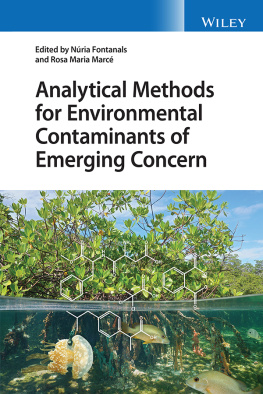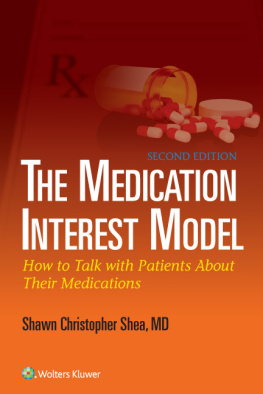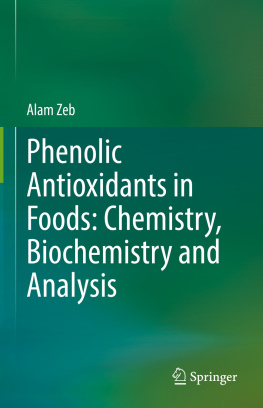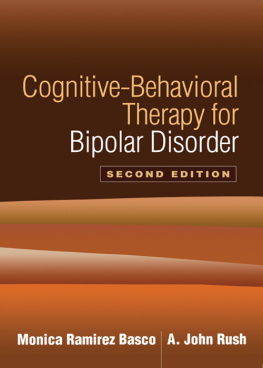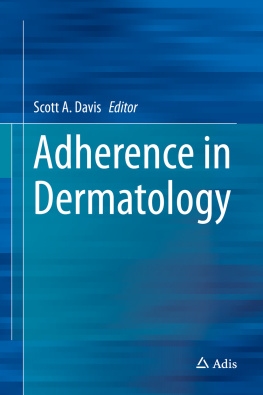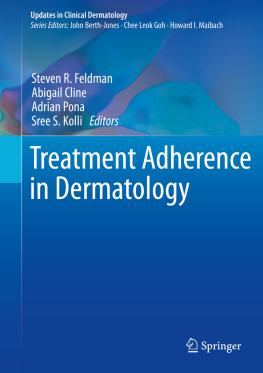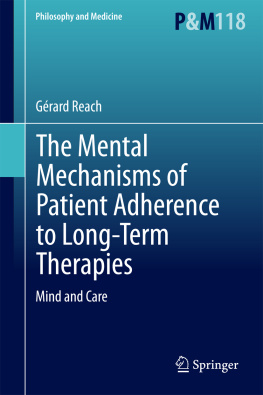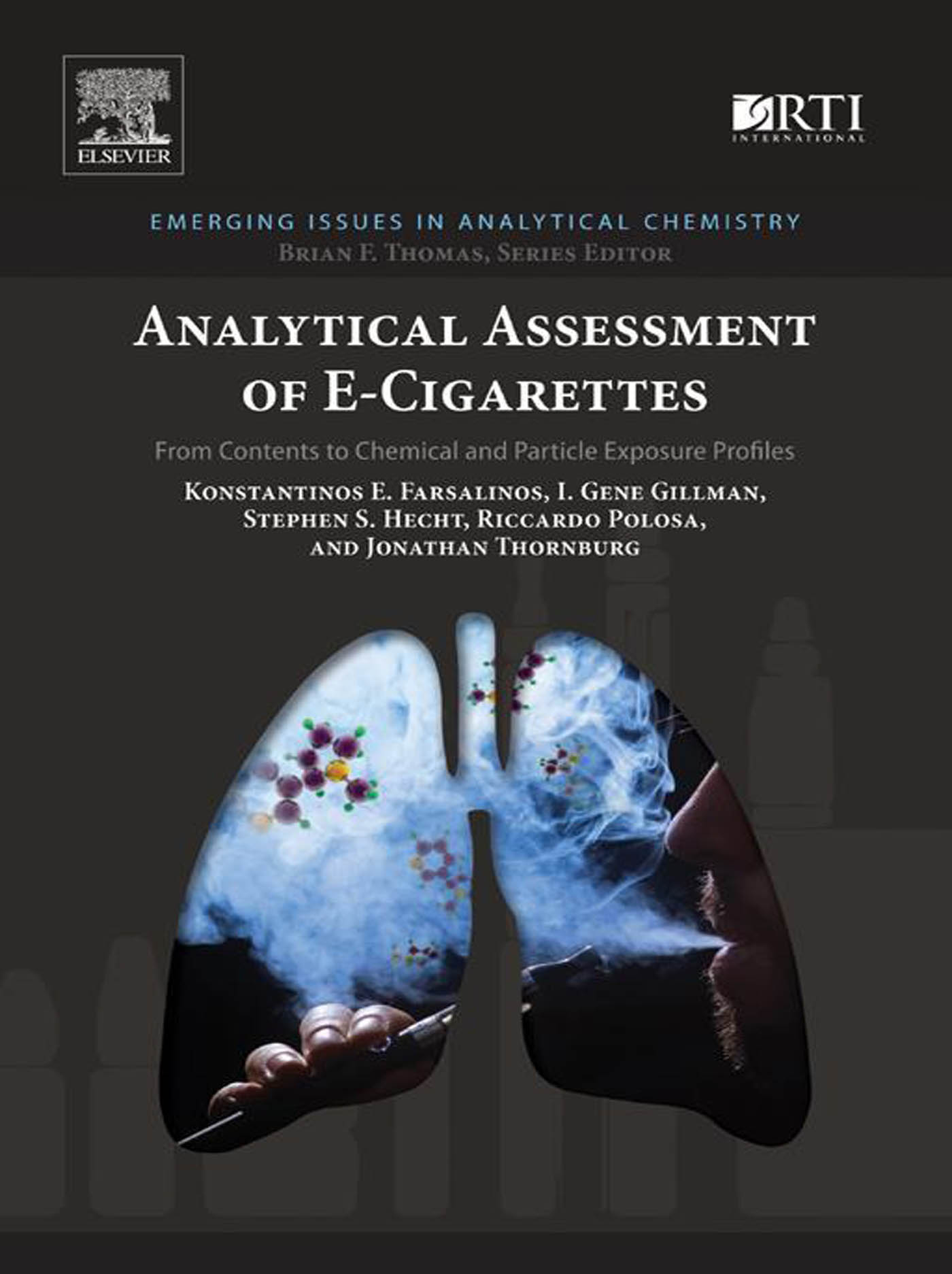Table of Contents
List of tables
- Tables in Chapter 2
- Tables in Chapter 3
- Tables in Chapter 4
- Tables in Chapter 5
List of illustrations
- Figures in Chapter 1
- Figures in Chapter 2
- Figures in Chapter 3
- Figures in Chapter 4
- Figures in Chapter 5
- Figures in Chapter 6
Landmarks
Table of Contents
Analytical Assessment of e-Cigarettes
From Contents to Chemical and Particle Exposure Profiles
Konstantinos E. Farsalinos
Onassis Cardiac Surgery Center, Athens, Greece and University of Patras, Patras, Greece
I. Gene Gillman
Enthalpy Analytical, Inc., Durham, NC, United States
Stephen S. Hecht
University of Minnesota, Minneapolis, MN, United States
Riccardo Polosa
University of Catania, Catania, Italy
Jonathan Thornburg
RTI International, Research Triangle Park, NC, United States
EMERING ISSUES IN ANALYTICAL CHEMISTRY
SERIES EDITOR
BRIN F. THOMAS

Copyright
Elsevier
Radarweg 29, PO Box 211, 1000 AE Amsterdam, Netherlands
The Boulevard, Langford Lane, Kidlington, Oxford OX5 1GB, United Kingdom
50 Hampshire Street, 5th Floor, Cambridge, MA 02139, United States
Copyright 2017 Elsevier Inc. All rights reserved.
Published in cooperation with RTI Press at RTI International, an independent, nonprofit research institute that provides research, development, and technical services to government and commercial clients worldwide (www.rti.org). RTI Press is RTIs open-access, peer-reviewed publishing channel. RTI International is a trade name of Research Triangle Institute.
No part of this publication may be reproduced or transmitted in any form or by any means, electronic or mechanical, including photocopying, recording, or any information storage and retrieval system, without permission in writing from the publisher. Details on how to seek permission, further information about the Publishers permissions policies and our arrangements with organizations such as the Copyright Clearance Center and the Copyright Licensing Agency, can be found at our website: www.elsevier.com/permissions.
This book and the individual contributions contained in it are protected under copyright by the Publisher (other than as may be noted herein).
Notices
Knowledge and best practice in this field are constantly changing. As new research and experience broaden our understanding, changes in research methods, professional practices, or medical treatment may become necessary.
Practitioners and researchers must always rely on their own experience and knowledge in evaluating and using any information, methods, compounds, or experiments described herein. In using such information or methods they should be mindful of their own safety and the safety of others, including parties for whom they have a professional responsibility.
To the fullest extent of the law, neither the Publisher nor the authors, contributors, or editors, assume any liability for any injury and/or damage to persons or property as a matter of products liability, negligence or otherwise, or from any use or operation of any methods, products, instructions, or ideas contained in the material herein.
British Library Cataloguing-in-Publication Data
A catalogue record for this book is available from the British Library
Library of Congress Cataloging-in-Publication Data
A catalog record for this book is available from the Library of Congress
ISBN: 978-0-12-811241-0
For Information on all Elsevier publications visit our website at https://www.elsevier.com

Publisher: John Fedor
Acquisition Editor: Kathryn Morrissey
Editorial Project Manager: Amy Clark
Production Project Manager: Paul Prasad Chandramohan
Cover Designer: Mathew Limbert
Typeset by MPS Limited, Chennai, India
Dedication
To my parents, Efthymios and Penelopi, for their devotion to family values and to the intellectual and social education of myself and my siblings.
K. E. Farsalinos
List of Contributors
N.L. Benowitz , University of Calilfornia, San Francisco, San Francisco, CA, United States
K.E. Farsalinos , Onassis Cardiac Surgery Center, Athens, Greece and University of Patras, Patras, Greece
I. Gene Gillman , Enthalpy Analytical, Inc., Durham, NC, United States
S.S. Hecht , University of Minnesota, Minneapolis, MN, United States
R. Polosa , University of Catania, Catania, Italy
J. Thornburg , RTI International, Research Triangle Park, NC, United States
Foreword
N.L. Benowitz
Professor of Medicine and Bioengineering & Therapeutic Sciences, Chief, Division of Clinical Pharmacology, University of California, San Francisco, San Francisco, CA, United States
Cigarette smoking has had a devastating effect on public health worldwide over the past 100 years and will continue to do so throughout the current century unless there is a substantial reduction in the prevalence of smoking. Compulsive smoking is driven by addiction to nicotine, but most of the harm from smoking is caused by exposure to tobacco combustion products. For many years, tobacco researchers and policy experts have entertained the idea that a clean source of nicotine that could be inhaled and provide similar rewarding effects as a cigarette might entice smokers away from cigarette smoking and lead either to quitting smoking or to long-term nicotine use without incurring the harm from tobacco combustion toxicants.
e-Cigarettes are nicotine delivery devices that deliver nicotine without combusting tobacco. These are battery-powered devices that heat a liquid composed of propylene glycol and/or vegetable glycerin, nicotine, and flavoring to form a vapor which rapidly aerosolizes and is inhaled like cigarette smoke. e-Cigarettes could be beneficial to public health if they help smokers quit smoking and possibly (at least for some health effects) reduce harm for those who smoke fewer cigarettes while using e-Cigarettes. On the other hand, there are several concerns about adverse effects of e-Cigarette use on a population level, including attracting youth and serving as a gateway to nicotine addiction and cigarette smoking, dual use with cigarettes resulting in lower rates of quitting smoking, renormalizing nicotine use and undermining smoke-free air legislation, and/or diverting smokers from proven smoking cessation treatment sessions.
One of the determinants of the net effect of e-Cigarettes on public health is the benefit versus harms, including the direct toxicity of e-Cigarette use. Assessing the toxicity of e-Cigarettes requires an understanding of the design and variability in device components and constituents of e-liquids and aerosols, both chemicals and particulates. Biomarkers of exposure to e-Cigarette toxicants in people are critical for extrapolating machine-tested e-Cigarette emission findings to actual human exposures.
This volume brings together a number of expert e-Cigarette researchers to explore the contents, chemical and particulate emissions, and human exposure to e-Cigarette constituents, as well as regulatory issues related to e-Cigarettes. The authors are Dr. Konstantinos Farsalinos, a cardiologist who has conducted research on e-Cigarette use epidemiology, the nature of e-Cigarette emissions, and cardiovascular effects of e-Cigarettes; Dr. I. Gene Gillman, an analytical chemist who has measured constituents of e-Cigarette aerosols; Dr. Jonathan Thornburg, an aerosol physicist who has studied e-Cigarette aerosol composition; Dr. Stephen Hecht, a toxicologist who has pioneered research on biomarkers of exposure to tobacco constituents; and Dr. Riccardo Polosa, a pulmonary physician who has conducted clinical trials of e-Cigarettes for smoking cessation and reduction, and has studied pulmonary effects of e-Cigarette use. These researchers present a highly informative review of the current state of understanding of the contents and toxicant properties of e-Cigarettes as of 2016. The material in this book will be of great interest to researchers and regulators addressing the health consequences of e-Cigarette use.


